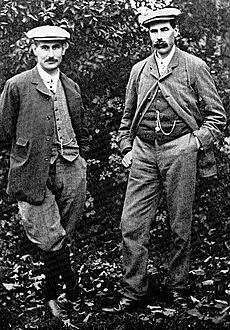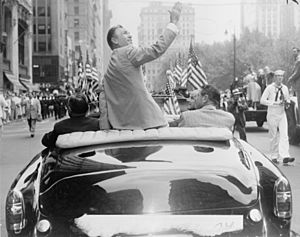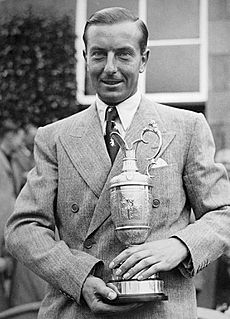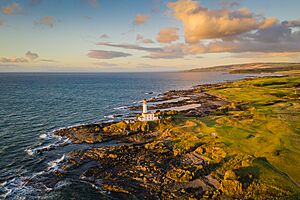The Open Championship facts for kids
 |
|
| Tournament information | |
|---|---|
| Established | 1860 |
| Course(s) | courses |
| Organised by | The R&A |
| Tour(s) | European Tour PGA Tour Japan Golf Tour |
| Format | Stroke play |
| Prize fund | US$17,000,000 |
| Month played | July |
| Tournament record score | |
| Aggregate | 264 Henrik Stenson (2016) |
| To par | −20 Henrik Stenson (2016) −20 Cameron Smith (2022) |
| Current champion | |
| Image:Golf current event.svg 2025 Open Championship | |
The Open Championship, often called The Open or the British Open, is the oldest golf tournament in the world. It's also one of the most important and famous. It started in 1860 in Scotland. At first, it was always held at Prestwick Golf Club. Later, it moved around to different special golf courses along the coast in the United Kingdom. The R&A organization runs the tournament.
The Open is one of the four biggest golf tournaments for men. The others are the Masters Tournament, the PGA Championship, and the U.S. Open. Since 2019, The Open has been the last major tournament of the year. It takes place in the middle of July.
It's called "The Open" because, in theory, anyone can play. This includes both professional and amateur golfers. Today, it's mostly for pros, but some top amateur players are invited or can qualify. Because The Open was so successful, many other "open" golf tournaments started around the world.
The winner gets the special title "The Champion Golfer of the Year." This title has been used since the very first Open in 1860. The champion also receives the Claret Jug, a beautiful trophy first given out in 1872. The current champion is American Scottie Scheffler. He won The Open in 2025 at Royal Portrush Golf Club.
Contents
- History of The Open
- The First Years (1860–1870)
- The Claret Jug and New Courses (1872–1889)
- English Winners and the Great Triumvirate (1890–1914)
- American Champions and New Courses (1920–1939)
- Hogan's Triple Crown and More International Winners (1946–1958)
- The Big Three: Player, Palmer, Nicklaus (1959–1974)
- Watson, Ballesteros, Faldo, and Norman (1975–1993)
- Tiger Woods and Today (1994 onwards)
- Open Traditions
- The Name "The Open"
- Tournament Status
- How The Open Works
- Prizes and Benefits
- Open Courses
- Open Records
- Recent Winners
- Silver Medal Winners
- Watching The Open
- See also
History of The Open
The First Years (1860–1870)
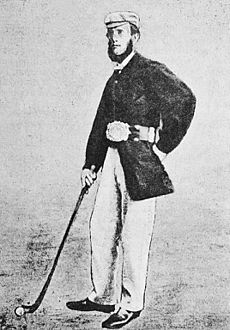
The very first Open Championship happened on October 17, 1860. It was played at Prestwick Golf Club in Scotland. Golf was mostly played by rich gentlemen back then. Clubs and balls were expensive. Professional golfers earned money by playing for bets, carrying golf bags (caddying), making clubs, and teaching.
A man named James Ogilvie Fairlie from Prestwick Golf Club decided to start a competition. He wanted to find out who was the best golfer after Allan Robertson, a famous pro, passed away. The winner received the Challenge Belt. This belt was made of red leather with a silver buckle and was worth £25.
Eight golfers played in the first event. Willie Park, Sr. won the championship by two shots. He was named "The Champion Golfer of the Year."
A year later, in 1861, the tournament became "open" to amateur players too. In 1863, they started giving out prize money to the golfers who finished second, third, and fourth. From 1864 onwards, the winner also received a cash prize.
Young Tom Morris won three times in a row from 1868 to 1870. Because of this amazing achievement, he was allowed to keep the Challenge Belt forever! Since there was no trophy, the tournament wasn't held in 1871.
The Claret Jug and New Courses (1872–1889)
On September 11, 1872, three golf clubs decided to work together. They were Prestwick, the Honourable Company of Edinburgh Golfers, and The Royal and Ancient Golf Club of St Andrews. They agreed to each pay £10 for a new silver trophy. This trophy became known as the Claret Jug. Its official name is The Golf Champion Trophy. They also decided that the Open would move between their three courses.
These decisions were made too late for the Claret Jug to be ready for the 1872 Open. Young Tom Morris won again that year. He received a medal instead, but his name was the first to be engraved on the Claret Jug. Winners have received medals ever since. Sadly, Young Tom Morris passed away in 1875 when he was only 24.
Scottish professional golfers continued to win most of the tournaments. The Open kept rotating between the three Scottish courses. It was played over 36 holes in one day until 1889.
English Winners and the Great Triumvirate (1890–1914)
In the 1890s, English golfers started winning The Open. In 1892, the tournament was played for the first time at Muirfield. This new course replaced Musselburgh Links. Later, St George's and Royal Liverpool in England were added to the list of host courses. From 1892, the tournament became longer. It was played over four 18-hole rounds across two days.
The time before World War I is famous for three amazing golfers: Harry Vardon (from Jersey), John Henry Taylor (England), and James Braid (Scotland). They were known as the "Great Triumvirate." Together, they won The Open Championship 16 times out of 21 tournaments between 1894 and 1914. Vardon won a record six times, and Braid and Taylor each won five times. Their rivalries made golf much more popular. However, the First World War stopped The Open from being held until 1920. None of these three golfers won another Open after that.
American Champions and New Courses (1920–1939)
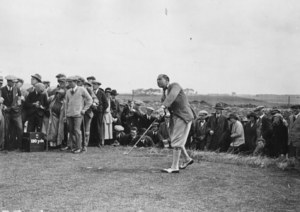
The Open returned in 1920, and The Royal and Ancient Golf Club became the only organizer. In 1926, they made the tournament last three days. It included qualifying rounds and a "cut," meaning only the top players continued to play.
In 1921, many American players traveled to Scotland to play. One of them, Jock Hutchison, who was born in Scotland but became an American citizen, won in St Andrews. In 1922, Walter Hagen became the first American-born winner. He went on to win four Opens. From 1923 to 1933, American-based players won every year. This included three wins by amateur Bobby Jones.
After 1925, Prestwick Golf Club was no longer used for The Open. It was too small for the growing number of fans. Carnoustie took its place and hosted for the first time in 1931. Other new courses added were Troon (1923) and Royal Lytham & St Annes (1926).
Hogan's Triple Crown and More International Winners (1946–1958)
After Second World War, The Open returned in 1946. American Sam Snead won at St Andrews. Bobby Locke from South Africa won three times between 1949 and 1952, and a fourth time in 1957.
Ben Hogan achieved something special in 1953. He had already won the Masters and the U.S. Open that year. Then, he won The Open in his only appearance, completing a "Triple Crown." He was so celebrated that he received a ticker-tape parade in New York City.
Peter Thomson from Australia became the first Australian winner. He won four times between 1954 and 1958, and a fifth time in 1965. In 1951, The Open was played outside England and Scotland for the first time, at Royal Portrush Golf Club in Northern Ireland.
The Big Three: Player, Palmer, Nicklaus (1959–1974)
In 1959, Gary Player from South Africa won his first Open. In 1960, Arnold Palmer came to Scotland after winning the Masters and U.S. Open. He wanted to win The Open too, like Ben Hogan did. He finished second but came back to win in 1961 and 1962. Palmer was very popular in America. His wins helped many Americans see The Open on TV for the first time. This, along with easier air travel, encouraged more Americans to play.
This time period is known for the competition between Player, Palmer, and Jack Nicklaus. They were called "The Big Three." Nicklaus won three times and finished second a record seven times. American Lee Trevino also won two Opens in a row in 1971 and 1972. The only British winner during this time was Tony Jacklin. Roberto De Vicenzo became the first winner from Argentina.
Watson, Ballesteros, Faldo, and Norman (1975–1993)
By 1975, The Open felt much like it does today. All the world's best players competed. American Tom Watson won in 1975. In 1977, at Turnberry, Watson had a famous "Duel in the Sun" with Jack Nicklaus. Watson won by one shot. He went on to win five Opens in total, a record only beaten by Harry Vardon. He is considered one of the best links golf players ever.
In 1976, 19-year-old Spaniard Seve Ballesteros finished second. He later won three Opens (1979, 1984, 1988). He was the first player from mainland Europe to win since 1907. Other players who won multiple times were Englishman Nick Faldo (three wins) and Australian Greg Norman (two wins).
Tiger Woods and Today (1994 onwards)
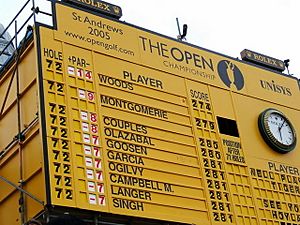
From 1994 to 2004, every year had a new winner. In 1999, The Open at Carnoustie was very tough. Frenchman Jean van de Velde had a big lead on the last hole but made a mistake. Scotsman Paul Lawrie, who was ranked 241st in the world, ended up winning in a playoff. He came from 10 shots behind, which was a record for any major tournament.
In 2000, Tiger Woods won The Open by a record 8 shots. He became the youngest player to win the career Grand Slam at age 24. He won again in 2005 and 2006, bringing his total to three wins. Other multiple winners in this time include South African Ernie Els and Irishman Pádraig Harrington.
In 2009, 59-year-old Tom Watson almost won, which would have made him the oldest major winner ever. He lost in a playoff to Stewart Cink. In 2016, Henrik Stenson from Sweden won with a record score of 264 (−20). Many compared his final round battle with Phil Mickelson to the famous "Duel in the Sun" from 1977.
Francesco Molinari became the first Italian major winner in 2018. Shane Lowry won in 2019 when The Open returned to Royal Portrush Golf Club.
The Open Championship was cancelled in 2020 because of the COVID-19 pandemic. This was the first time it had been cancelled since World War II.
Open Traditions
Links Golf Courses
The Open is always played on a special type of course called a links golf course. These courses are found along the coast. Links golf is often called the "purest" form of golf. It connects to how the game started in Scotland hundreds of years ago.
Links courses are usually open, with no trees, and have sandy, bumpy ground. Nature often shapes these courses. The weather, especially the wind, plays a big part. Golfers often have to change how they play to keep the ball low and avoid the wind. These courses are also known for their deep, round "pot bunkers" and thick gorse bushes.
The Old Course at St Andrews
The Old Course at St Andrews is thought to be the oldest golf course in the world. Winning The Open there is a huge achievement for any golfer. Because it's so special, The Open is usually played at St Andrews every five years.
Many past champions choose St Andrews for their last Open tournament. It's a tradition for them to walk down the 18th fairway to loud cheers. They often stop for photos on the Swilcan Bridge, with the beautiful clubhouse behind them.
The Claret Jug Trophy
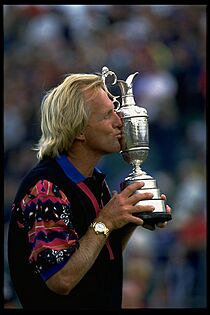
The Open trophy is the Claret Jug. It has been given to the champion since 1873. The original Claret Jug stays on display at The R&A's Clubhouse in St Andrews. The winner gets a copy of the trophy to keep for a year. They must return it before the next Open.
The winner of The Open is called "The Champion Golfer of the Year." This title has been used since the first Open in 1860. Champions often take photos with the trophy sitting on one of the famous pot bunkers. Three-time winner Jack Nicklaus said holding the Claret Jug was like holding "a newborn baby."
The Name "The Open"
The first event in 1860 was by invitation only. But the next year, the club said the competition "shall be open to all the world." In its early years, it was just called "The Championship." Later, to tell it apart from other tournaments, it became known as The Open Championship or simply The Open.
This tournament inspired other countries to start their own "open" golf events, like the U.S. Open. To avoid confusion, many countries started calling it the "British Open." However, The R&A, which organizes the tournament, always called it The Open Championship.
Since 2017, The R&A has been working to make sure everyone calls it "The Open." They want it to have one clear name everywhere. Their website even has a statement explaining why it's called "The Open" and not the "British Open."
Tournament Status
The Open is one of the four major championships in golf. It's an official event on the PGA Tour, European Tour, and the Japan Golf Tour.
When The Open started in 1860, it wasn't the most popular golf event. Challenge matches between top golfers were more exciting to watch. But the "Great Triumvirate" (Vardon, Taylor, and Braid) helped make The Open more popular.
After World War II, fewer American golfers came to The Open. The prize money in the U.S. was much higher, and travel was expensive. But famous visits and wins by Ben Hogan and Arnold Palmer, along with cheaper flights and TV coverage, helped The Open become very important again.
Today, The Open is one of the four "majors" in golf. These are the most important tournaments, and how a golfer performs in them often defines their career. People often debate whether The Open, the U.S. Open, or the Masters is the most important major.
How The Open Works
Qualifying to Play
Qualifying rounds were added in 1907. Today, most players don't have to qualify. They get an "exemption" because they've done well in past Opens, other major tournaments, or are high in the Official World Golf Ranking. Five amateur players can also get in by winning big amateur titles.
Another way to qualify is through the Open Qualifying Series. These are about twelve golf events around the world. Any male professional golfer, or amateur golfer with a good handicap, can try to enter local qualifying. If they do well, they move on to Final Qualifying. This is held at four different courses in the UK, and 12 players earn a spot in The Open. In total, 156 players compete in The Open.
Tournament Format
- Players: 156 golfers compete.
- How it's played: It's a 72-hole stroke play event. Players play 18 holes each day for four days, if the weather allows.
- When it starts: The tournament begins on the Thursday before the third Friday in July.
- Tee off times: For the first two days, players tee off in groups of three, with a mix of morning and afternoon times. On the last two days, players go out in groups of two, with the leaders teeing off last.
- The Cut: After 36 holes (two rounds), only the top 70 players (and anyone tied with them) get to play the final 36 holes.
- Playoff: If there's a tie for the lead after 72 holes, they play a three-hole playoff. If it's still tied after that, they go to "sudden death," meaning the first player to win a hole wins the championship.
Prizes and Benefits
Before 2017, the prize money was always in British pounds (£). But in 2017, it changed to US dollars ($) because that's the most common currency for golf prize money worldwide.
Champion's Prizes
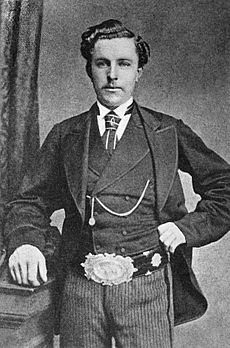
The champion receives trophies, prize money, and special entries into other golf tournaments. They also usually get extra money from their sponsors. Here's what the winner gets:
- The Claret Jug: The winner keeps a replica of the famous trophy for a year.
- Gold Medal: A special gold medal is given to the champion.
- Prize Money: If the winner is a professional, they get 18% of the total prize money.
- Future Open Entries: They are guaranteed to play in all future Open Championships until they are 55 years old. They also get entry to the next ten Opens, even if they are over 55.
- Other Major Entries: They get to play in the next five Masters, PGA Championship, and U.S. Open tournaments.
- Tour Memberships: They get a five-year membership to the PGA Tour and the European Tour.
From 1860 to 1870, the winner received the Challenge Belt. When Young Tom Morris won it three times in a row, he got to keep it forever. Then, the gold medal (from 1872) and the Claret Jug (from 1873) became the main prizes.
Other Prizes
Players who finish high in The Open also get benefits:
- Silver Salvers: The players who finish second receive a silver plate.
- Prize Money: Professional players who make the cut get a share of the prize money. The higher they finish, the more they get.
- Future Open Entry: The top 10 players (including ties) get to play in the next Open Championship.
- Masters Entry: The top 4 players (including ties) get to play in the next Masters Tournament.
Amateur Medals
Since 1949, the best amateur player who finishes all 72 holes receives a silver medal. Since 1972, any other amateur who finishes all rounds gets a bronze medal. Amateurs do not receive prize money.
Open Courses
The Open Championship has always been held on a coastal links golf course in Scotland, England, or Northern Ireland.
Course Overview
A total of 14 courses have hosted The Open. Ten of these are still used today, and four are no longer part of the rotation.
- Prestwick Golf Club: This was the original home of The Open. It hosted 24 Opens, including the first 12. It was removed from the list after 1925 because it became too crowded for the growing event.
- Old Course at St Andrews: This is considered the oldest golf course in the world and is known as "the home of golf." It usually hosts The Open every five years because of its special status.
- Musselburgh Links: This 9-hole course hosted six Opens. It was replaced by Muirfield in 1892.
- Muirfield: This course was built to replace Musselburgh. It's known for its circular layout, which means the wind changes direction on each hole.
- Royal St George's Golf Club: Often called Sandwich, this was the first course in England to host The Open. It has the deepest bunker on the list of courses.
- Royal Liverpool Golf Club: Also known as Hoylake. It returned to hosting in 2006 after many years.
- Royal Cinque Ports Golf Club: This course hosted in 1909 and 1920. It was removed from the list because high tides flooded it twice.
- Royal Troon Golf Club: First used in 1923. It has famous holes like the "Postage Stamp" (8th hole).
- Royal Lytham & St Annes Golf Club: This course is shorter but has 167 bunkers, so players need to be very accurate.
- Carnoustie Golf Links: This course replaced Prestwick. It's known as the toughest Open venue, especially the last three holes.
- Prince's Golf Club: This course only hosted The Open once, in 1932.
- Royal Portrush Golf Club: This is the only course outside England and Scotland to host The Open. It hosted in 1951 and returned in 2019.
- Royal Birkdale Golf Club: This course is known for its tall sand dunes along the fairways. It's often called England's best Open course.
- Turnberry: This course hosted its first Open in 1977, with the famous "Duel in the Sun." It's known for being very beautiful.
Open Records
- Oldest winner: Old Tom Morris, who was 46 years old in 1867.
- Youngest winner: Young Tom Morris, who was 17 years old in 1868.
- Most wins: 6 wins by Harry Vardon.
- Most wins in a row: 4 wins by Young Tom Morris (1868, 1869, 1870, 1872 – no tournament in 1871).
- Lowest score (72 holes): 264 by Henrik Stenson in 2016.
- Lowest score compared to par: −20 by Henrik Stenson (2016) and Cameron Smith (2022).
- Biggest winning lead: 13 strokes by Old Tom Morris in 1862.
- Lowest single round: 62 by Branden Grace in 2017. This is a record for all major tournaments.
- Most second-place finishes: 7 by Jack Nicklaus.
Recent Winners
| # | Year | Winner | Score | To par | Margin of victory |
Runner(s)-up | Purse | Winner's share |
Venue | |
|---|---|---|---|---|---|---|---|---|---|---|
| 153rd | 2025 | 267 | −17 | 4 strokes | 17,000,000 | 3,100,000 | Royal Portrush | |||
| 152nd | 2024 | 275 | −9 | 2 strokes | 17,000,000 | 3,100,000 | Royal Troon | |||
| 151st | 2023 | 271 | −13 | 6 strokes | 16,500,000 | 3,000,000 | Royal Liverpool | |||
| 150th | 2022 | 268 | −20 | 1 stroke | 14,000,000 | 2,500,000 | St Andrews | |||
| 149th | 2021 | 265 | −15 | 2 strokes | 11,500,000 | 2,070,000 | Royal St George's | |||
| – | 2020 | Cancelled due to the COVID-19 pandemic | ||||||||
| 148th | 2019 | 269 | −15 | 6 strokes | 10,750,000 | 1,935,000 | Royal Portrush | |||
| 147th | 2018 | 276 | −8 | 2 strokes | 10,500,000 | 1,890,000 | Carnoustie | |||
| 146th | 2017 | 268 | −12 | 3 strokes | 10,250,000 | 1,845,000 | Royal Birkdale | |||
| 145th | 2016 | 264 | −20 | 3 strokes | 6,500,000 | 1,175,000 | Royal Troon | |||
| 144th | 2015 | 273 | −15 | Playoff | 6,300,000 | 1,150,000 | St Andrews | |||
Silver Medal Winners
Since 1949, the best amateur player who finishes all 72 holes receives a silver medal. In the past, rich amateurs could win this medal many times. Today, many players turn professional soon after winning it. Tiger Woods and Rory McIlroy are the only silver medal winners who later won The Open as professionals.
- 1949 –
 Frank Stranahan
Frank Stranahan - 1950 –
 Frank Stranahan (2)
Frank Stranahan (2) - 1951 –
 Frank Stranahan (3)
Frank Stranahan (3) - 1952 –
 Jackie Jones
Jackie Jones - 1953 –
 Frank Stranahan (4)
Frank Stranahan (4) - 1954 –
 Peter Toogood
Peter Toogood - 1955 –
 Joe Conrad
Joe Conrad - 1956 –
 Joe Carr
Joe Carr - 1957 –
 Dickson Smith
Dickson Smith - 1958 –
 Joe Carr (2)
Joe Carr (2) - 1959 –
 Reid Jack
Reid Jack - 1960 –
 Guy Wolstenholme
Guy Wolstenholme - 1961 –
 Ronnie White
Ronnie White - 1962 –
 Charlie Green
Charlie Green - 1963 – none
- 1964 – none
- 1965 –
 Michael Burgess
Michael Burgess - 1966 –
 Ronnie Shade
Ronnie Shade - 1967 – none
- 1968 –
 Michael Bonallack
Michael Bonallack - 1969 –
 Peter Tupling
Peter Tupling - 1970 –
 Steve Melnyk
Steve Melnyk - 1971 –
 Michael Bonallack (2)
Michael Bonallack (2) - 1972 – none
- 1973 –
 Danny Edwards
Danny Edwards - 1974 – none
- 1975 – none
- 1976 – none
- 1977 – none
- 1978 –
 Peter McEvoy
Peter McEvoy - 1979 –
 Peter McEvoy (2)
Peter McEvoy (2) - 1980 –
 Jay Sigel
Jay Sigel - 1981 –
 Hal Sutton
Hal Sutton - 1982 –
 Malcolm Lewis
Malcolm Lewis - 1983 – none
- 1984 – none
- 1985 –
 José María Olazábal
José María Olazábal - 1986 – none
- 1987 –
 Paul Mayo
Paul Mayo - 1988 –
 Paul Broadhurst
Paul Broadhurst - 1989 –
 Russell Claydon
Russell Claydon - 1990 – none
- 1991 –
 Jim Payne
Jim Payne - 1992 –
 Daren Lee
Daren Lee - 1993 –
 Iain Pyman
Iain Pyman - 1994 –
 Warren Bennett
Warren Bennett - 1995 –
 Steve Webster
Steve Webster - 1996 –
 Tiger Woods
Tiger Woods - 1997 –
 Barclay Howard
Barclay Howard - 1998 –
 Justin Rose
Justin Rose - 1999 – none
- 2000 – none
- 2001 –
 David Dixon
David Dixon - 2002 – none
- 2003 – none
- 2004 –
 Stuart Wilson
Stuart Wilson - 2005 –
 Lloyd Saltman
Lloyd Saltman - 2006 –
 Marius Thorp
Marius Thorp - 2007 –
 Rory McIlroy
Rory McIlroy - 2008 –
 Chris Wood
Chris Wood - 2009 –
 Matteo Manassero
Matteo Manassero - 2010 –
 Jin Jeong
Jin Jeong - 2011 –
 Tom Lewis
Tom Lewis - 2012 – none
- 2013 –
 Matt Fitzpatrick
Matt Fitzpatrick - 2014 – none
- 2015 –
 Jordan Niebrugge
Jordan Niebrugge - 2016 – none
- 2017 –
 Alfie Plant
Alfie Plant - 2018 –
 Sam Locke
Sam Locke - 2019 – none
- 2020 – no tournament
- 2021 –
 Matti Schmid
Matti Schmid - 2022 –
 Filippo Celli
Filippo Celli - 2023 –
 Christo Lamprecht
Christo Lamprecht - 2024 –
 Calum Scott
Calum Scott
Watching The Open
The Open is broadcast around the world. In the United Kingdom, Sky shows the tournament live. The BBC shows highlights. In the United States, NBC broadcasts The Open.
The R&A, which runs The Open, wants all broadcasters to call it "The Open." They don't want it called the "British Open" anymore.
The Open's website, TheOpen.com, also offers some free coverage. This includes highlights and special views of certain groups and holes.
See also
 In Spanish: Abierto Británico de Golf para niños
In Spanish: Abierto Británico de Golf para niños


